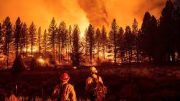By James Careless
At about 27,000 square miles covering parts of Arizona, New Mexico, and Utah, the Navajo Nation is one of the largest native reservations in the United States. Approximately 180,000 Navajo (out of a total population of 400,000) live on Diné Bikéyah, or Navajoland. This comes out to a population average of just under seven people per square mile.
Because the Navajo Nation covers such a large area with a comparatively small population, providing adequate communications for 911, voice, and internet access is a real challenge. When it comes to emergency response, for instance, “we have what is known as a ‘quasi 911′ service,” said Tico Charlee, Director of Telecommunications with the Navajo Nation Telecommunications Regulatory Commission (NNTRC), which regulates all telecom providers in Diné Bikéyah. Although 911 service exists, poor connectivity in this region means that calls often get dropped. Meanwhile, since the existing 911 system isn’t able to handle all the calls that do get through, “the traffic gets so overwhelming for our staff that successful calls still get missed.”
In a bid to remedy this situation, the Navajo Nation applied for and is receiving a $50,830,943.87 National Telecommunications and Information Administration (NTIA) grant from this agency’s Tribal Broadband Connectivity Program (TBCP). This is a $3 billion federal program directed at tribal governments to be used for broadband deployment on tribal lands, as well as for first response telehealth, distance learning, broadband affordability, and digital inclusion. This specific grant aims to fiber, fixed wireless, and 2.5 GHz wireless networks to directly connect 20,827 unserved and underserved Native American households with fiber-to-the-home and/or fixed wireless to the home service up to 1 Gbps.
When it comes to improving first response on Navajoland, the NNTRC’s goal is to upgrade its current 911 system to Enhanced 911 (E911) standards and call capacities. This will allow the region’s Public Safety Answering Points (PSAPs) to locate the geographical position of landline callers, and the cell tower closest to wireless callers. For non-Native Americans, E911 has been a way of life for many years. But for the Navajo Nation, bringing this level of 911 service to its residents will support a significant improvement in the quality and timeliness of service they receive from first responders.
There will also be 92-95 more cell towers installed across Diné Bikéyah. This will improve wireless network access to its 180,000 residents, substantially reducing the number of dropped calls to 911 and other connections. NTUA, the Navajo Tribal Utility Authority, working in conjunction with NNTRC and FirstNet solutions will improve the reliability and sustained connectivity to help first responders, medical workers, and other emergency personnel to operate safer, faster, and more efficiently. In addition, the NTUA also proposed to work with the Navajo Nation to upgrade the Navajo Nation’s Public Safety Vehicles to enhance Mobile satellite-based broadband connectivity. The Navajo Nation will also upgrade the communications equipment used by its first responders, including connecting tribal EMS, fire, and police to FirstNet. “We will be upgrading everything they have,” said Charlee. “This will work because all of the service providers who serve us have agreed to connect our first responders with FirstNet, whether it’s by co-locating on some of the cellular/microwave towers already in place or building new ones. Out of 27,000 square miles, we have an abundance of places that don’t have wireless connectivity. That’s already starting to change.”
To justify its case for the NTIA TBCP grant, the Navajo Nation explained the detrimental impact of poor connectivity on its people. Take law enforcement: Navajoland only has 218 police officers to cover its entire territory and respond to 150,0000-200,000 calls annually. Having better widespread connectivity will allow this small force to do its job more effectively, making this land “more safe and secure,” Charlee said. “We will achieve equipment and service standardization across our various first responder agencies. Meanwhile, the enhanced broadband connectivity will improve services like education, telehealth, and our people’s access to the internet.”
The Navajo Nation also made a point of reaching out to its communities and listening to their concerns before drafting its TBCP grant application. “We got quite a bit of response from the grassroots people saying what they needed,” said Charlee. “We heard them and did our best to respond to their needs in our plan. That made a difference when it came to making our case to the NTIA.”
Having received this $50 million grant in 2022, the Navajo Nation has wasted no time in improving its connectivity infrastructure. “We’d like to get this thing done by next year, and it’s already in motion right now,” Tico Charlee said. “When completed, it will bring more emergency connectivity and show the impact of the community by getting more involved in this process and getting it done.”



Be the first to comment on "Navajo Nation to Boost Broadband Connectivity Using NTIA TBCP Grant"